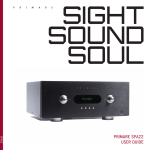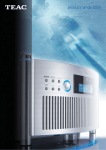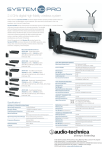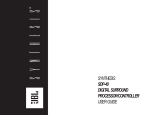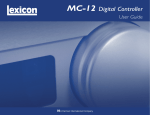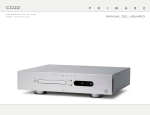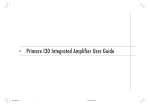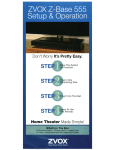Download Primare SP32 User guide
Transcript
SP32 primare SP32 User guide Important safety instructions Copyright © 2008 Primare Systems AB. All rights reserved. Primare Systems AB Renvägen 1 SE-352 45 Växjö Sweden http://www.primare.net Issue: SP32/1 The information in this guide is believed to be correct as of the date of publication. However, our policy is one of continuous development and so the information is subject to change without notice, and does not represent a commitment on the part of Primare Systems AB. Primare is a trademark of Primare Systems AB. This guide was produced by Human-Computer Interface Ltd. http://www.interface.co.uk Safety compliance This product has been designed to meet the IEC 60065 international electrical safety standard. CAUTION ATTENTION RISK OF ELECTRIC SHOCK DO NOT OPEN RISQUE DE CHOC ELECTRIQUE NE PAS OUVRIR CAUTION: To reduce the risk of electrical shock do not remove cover (or back). No user serviceable parts inside. Refer servicing to qualified service personnel. WARNING: To reduce the risk of fire or electrical shock, do not expose this apparatus to rain or moisture. CAUTION: In Canada and the USA, to prevent electric shock, match the wide blade of the plug to the wide slot in the socket and insert the plug fully into the socket. This product is designed and manufactured to meet strict quality and safety standards. However, you should be aware of the following installation and operation precautions. 1. Take heed of warnings & instructions You should read all the safety and operating instructions before operating this appliance. Retain this handbook for future reference and adhere to all warnings in the handbook or on the appliance. 2. Water and moisture The presence of electricity near water can be dangerous. Do not use the appliance near water – for example next to a bathtub, washbowl, kitchen sink, in a wet basement or near a swimming pool, etc. 3. Object or liquid entry Take care that objects do not fall and liquids are not spilled into the enclosure through any openings. Liquid-filled objects such as vases should not be placed on the equipment. 4. Ventilation Do not place the equipment on a bed, sofa, rug or similar soft surface, or in an enclosed bookcase or cabinet, since ventilation may be impeded. We recommend a minimum distance of 50mm around the sides and top of the appliance to provide adequate ventilation. 5. Heat Locate the appliance away from naked flames or heat producing equipment such as radiators, stoves or other appliances (including other amplifiers) that produce heat. 6. Climate The appliance has been designed for use in moderate climates. The lightning flash with an arrowhead symbol within an equilateral triangle, is intended to alert the user to the presence of uninsulated 'dangerous voltage' within the product's enclosure that may be of sufficient magnitude to constitute a risk of electric shock to persons. The exclamation point within an equilateral triangle is intended to alert the user to the presence of important operating and maintenance (servicing) instructions in the literature accompanying the product. 7. Racks and stands Only use a rack or stand that is recommended for use with audio equipment. If the equipment is on a portable rack it should be moved with great care, to avoid overturning the combination. 11. Grounding Ensure that the grounding means of the appliance is not defeated. 8. Cleaning Unplug the unit from the mains supply before cleaning. 13. Non-use periods If the unit has a stand-by function, a small amount of current will continue to flow into the equipment in this mode. Unplug the power cord of the appliance from the outlet if left unused for a long period of time. The case should normally only require a wipe with a soft, damp, lint-free cloth. Do not use paint thinners or other chemical solvents for cleaning. We do not advise the use of furniture cleaning sprays or polishes as they can cause indelible white marks if the unit is subsequently wiped with a damp cloth. 9. Power sources This appliance must be connected to a mains socket outlet using the supplied power cord. To disconnect this apparatus from power, you must disconnect the power cord. Make sure the power cord is always easily accessible. Only connect the appliance to a power supply of the type described in the operating instructions or as marked on the appliance. This is a Class 1 device and must be earthed. 10. Power-cord protection Power supply cords should be routed so that they are not likely to be walked on or pinched by items placed upon or against them, paying particular attention to cords and plugs, and the point where they exit from the appliance. 12. Power lines Locate any outdoor antenna/aerial away from power lines. 14. Abnormal smell If an abnormal smell or smoke is detected from the appliance, turn the power off immediately and unplug the unit from the wall outlet. Contact your dealer immediately. 15. Servicing You should not attempt to service the appliance beyond that described in this handbook. All other servicing should be referred to qualified service personnel. 16. Damage requiring service The appliance should be serviced by qualified service personnel when: A. the power-supply cord or the plug has been damaged, or B. objects have fallen, or liquid has spilled into the appliance, or C. the appliance has been exposed to rain, or D. the appliance does not appear to operate normally or exhibits a marked change in performance, or E. the appliance has been dropped or the enclosure damaged. PRIMARE SP32 :: PAGE Copyright and acknowledgments Welcome Welcome to the Primare SP32! Your SP32 is an advanced surround sound processor with the latest sound and video processing, making it the ultimate choice for home theatre. Here is how to set up your SP32 in seven simple steps: 1 Unpack the SP32 3 Connect a display 5 Connect power 7 Play a source Your SP32 is supplied with the following components: While configuring your SP32 you should connect it to your television or display using one of the following options, so you can use the on-screen display: • Plug one end of the mains cable supplied with the SP32 into the power connector on the back panel, and connect the other end to a wall socket. • Use the SELECTOR control on the front panel or the A and V buttons on the remote control to select the source. • Switch on the SP32, using the switch next to the power connector on the back panel. • Use the VOLUME control on the front panel or the + and – buttons on the remote control to increase or decrease the volume. • Press the O button to switch on the SP32. • Mains cable. • C22 remote control. • Two batteries for the remote control. If any of these items are missing please contact your supplier. We recommend you retain the packaging in case you need to transport the unit at a later date. 2 Connect to power amplifiers and speakers The SP32 can drive up to seven fullfrequency channels and one subwoofer. If your surround system does not include a full set of speakers, the SP32 will distribute the signals from these channels to the other channels as appropriate in your system. • • Connect the front, centre, surround, and surround back outputs to the corresponding inputs on the amplifiers. If your system includes a subwoofer, connect the sub main output to the audio input of the subwoofer. • Y, Pr, Pb (Component) • S-Video • CVBS (Composite) The SP32 also supports: • HDMI (or DVI with a suitable lead) For more information see Video connections, page 3. 4 Connect sources The SP32 is supplied with 9 standard sources already configured; see Selecting a source, page 4. For example, to connect a DVD player: • Connect the component output to Component 1 on the SP32. • Connect the digital audio output to digital input 4 on the SP32. Alternatively you can configure up to 15 sources to use the particular combination of analogue, digital, and video input you prefer; for more information see Input settings, page 6. The button indicators will light up, showing the function of the two controls and four buttons on the front panel. 6 Configure the speakers Before using the SP32 you need to configure it to specify the combination of speakers you have in your surround system. For more information see Speaker settings, page 7. You then need to set up the speaker levels and speaker distances, to ensure that the sound image is correctly focused at the listening position. For more information see Level settings, page 7, and Speaker distance, page 7. For more information about playing sources see Selecting a source, page 4. Connecting the SP32 This page shows how to connect your SP32 to other equipment in your system. Video inputs Video outputs Component Composite HDMI S-Video HDMI S-Video Component inputs Digital outputs HDMI INPUTS VIDEO OUTPUTS DIGITAL OUT HDMI IR INPUT COMPOSITE VIDEO INPUTS DIGITAL INPUTS COMPONENT COMPONENT VIDEO INPUTS ZONE2 S-VIDEO INPUTS RS232 DIGITAL INPUT 7 ANALOG INPUTS ANALOG OUTPUTS OFF ON AES/EBU DC TRIGGER Digital Trigger inputs outputs Power Balanced Analogue inputs inputs pairs of analog inputs for a single, multi-channel source, such as SACD. Connect the power connector on the back panel to your power outlet using the mains cable supplied with the SP32. If this cable is not suitable for your power outlets contact your supplier for an alternative cable. ANALOG INPUT 10 WARNING: Always disconnect the SP32 from the mains power before connecting or disconnecting any cables. Main outputs The SP32 provides eight discrete analog audio outputs for connecting to the power amplifiers and loudspeakers in the surround system. Each output is provided in both an unbalanced and a balanced version. Audio inputs The SP32 provides a total of ten analog inputs and seven digital inputs. Because the SP32 is configurable, you have total flexibility about which input you use for each of your sources. In addition, you can optionally use four The SP32 is supplied with a suggested set of sources already set up, and you may choose to leave the inputs assigned in this way. However, if you prefer, you can re-assign the inputs to sources in any way you prefer. Digital inputs The SP32 provides a total of seven digital inputs: one AES/EBU digital input, three SPDIF digital inputs, and three optical TOSlink digital inputs. Analog inputs The SP32 provides eight line-level stereo RCA inputs and two XLR inputs for connection to a source providing balanced outputs. Video connections The SP32 provides a choice of either HDMI, component, S-Video, or composite video connections. If your source or monitor provides a choice we recommend using the HDMI or component connections, as these provide higher quality. However, we recommend you first connect up and calibrate your system using the composite connection. ANALOG OUTPUTS Balanced outputs Analogue outputs Power Video inputs The SP32 provides three HDMI, three component video, three S-Video, and four composite video inputs. Video outputs The SP32 provides HDMI, component video, S-Video, and composite video outputs. The on-screen display is provided on all the video outputs except HDMI. Connecting to a television or monitor Connect the appropriate output to your television or display. If your television includes a tuner output you can use the SP32 to perform switching between the television tuner and your other video sources such as DVD or Blu-ray. In this case connect the television tuner output to the video input corresponding to your TV source. If your television does not provide a tuner output you will need to switch the television between its internal tuner and the external video input. Zone 2 An additional audio, S-Video, and composite output is provided to feed a second zone, such as a second room system. Record outputs The SP32 provides two digital record outputs, SPDIF and optical TOSlink, and one analog RCA record output. IR, RS232, and Triggers The IR input allows you to connect an external infra-red eye, for operation of the SP32 if the front panel is inaccessible. The RS232 input allows an authorized dealer to connect the SP32 to a computer, for service and future upgrades. For more information contact Primare or see the Primare Audio Web site at www.primaresystems.com. The Trigger outputs allow the SP32 to control external equipment, such as power amplifiers, or a projector screen. PRIMARE SP32 :: PAGE ANALOG INPUT 9 Using the SP32 This page explains how to operate your SP32, with an explanation of the function of each of the front panel controls. Display P R I M A R E %84%2.!, 3!#$ SELECTOR VOLUME Selector Menu Select Level Mute/ Standby Volume Front panel controls Front panel display Selecting a source Almost all the functions of the SP32 Multi-Channel Processor can be accessed using the two front panel controls and four push buttons, and information about its operation is displayed on the front panel display: The front panel display shows: The SP32 allows you to define up to 15 sources. Each source can use one of the seven digital and ten analog inputs, and any source can be combined with one of the video inputs. Alternatively, a multi-channel source, called EXTERNAL 7.1, can be defined using analog inputs 5 to 8. Selector Selects an input, or operates the onscreen menus Menu @ Selects the on-screen menus. Select R Selects the current menu option. Level _ Selects which setting you change with the VOLUME control. Mute/Standby O Press briefly to mute the sound. Hold down to switch the SP32 to standby. Volume Adjusts the volume. • The processing mode; eg STEREO, or NO LOCK if there is no signal on a digital input. • The current source; eg DVD • The volume; eg 41 or MUTE. To blank the front panel display • Press the DIM button on the remote control. The normal display will reappear while you adjust any settings. Press the DIM button again to restore the display. any source to use different inputs, or configure your own sources with any name you choose and using any particular inputs as appropriate for the source. To select a source When the SP32 is first supplied the nine standard sources shown below are already set up for you. • Turn the SELECTOR control on the front panel until the name of the source is shown on the front panel display. • Alternatively, press the A or V buttons on the remote control to step between sources. You can simply disable any of these sources that you do not need; see Input settings, page 6. You can also change Switching on and off Source Audio Video 2CH mode Description CD Analog 9 None Bypass High quality CD player To switch on DVD Digital 4 Component 1 Stereo DVD player • BLU-RAY HDMI 1 HDMI 1 Stereo Blu-Ray disc player SACD External 7.1 Composite 1 N/A SACD player SAT Digital 1 S-Video 1 PLIIX Movie Satellite receiver DVB HDMI 2 HDMI 2 PLIIX Movie Digital satellite receiver DVB-T Digital 2 Composite 2 PLIIX Movie Digital television receiver To switch on from standby VCR Analog 1 Composite 3 PLIIX Movie Video cassette recorder • Tuner Analog 2 None Bypass FM tuner Use the switch on the back panel. During normal operation you can leave the SP32 switched on and in standby. To switch to standby • Hold down the O button on the front panel or remote control. Press the O button on the front panel or remote control. The first step allows you to change the balance of the main speakers: The SP32 allows you to vary the volume from 0 (silence) to 99 (maximum volume), where each step is equivalent to 0.5dB. 0.0dB To change the volume CENTER 0.0dB • SUBWOOFER 0.0dB SURROUND 0.0dB SURR BACK 0.0dB Rotate the VOLUME control on the front panel, or press the + or – buttons on the remote control. The current volume setting is shown on the front panel display; for example: DVD STEREO • • Press the O or MUTE button again. The sound is also restored to its original volume if you increase the volume. Changing the balance, center, surround, surround back, and subwoofer levels You can independently change the balance, center level, surround level, surround back level, and subwoofer level to alter the balance of sound in your surround system. Changing the balance alters the level of both the left and right main loudspeakers to shift the position of the stereo image, keeping the overall level of the sound the same. The other adjustments change the level of the corresponding speaker(s) without affecting the remaining speakers in the surround system. To change a level • Press the _ button on the front panel, or the BAL/ST button on the remote control, until the display shows the level you want to change. Use the VOLUME control on the front panel, or the + and – buttons on the remote control, to adjust the value of the level. If you are listening to a conventional two-channel analog or digital source, such as a CD, the following options are available: Option Description BYPASS (analog sources only) The inputs are fed directly to the output, with no decoding for the most faithful possible reproduction of stereo or multi-channel sources. STEREO Conventional stereo, using just the main left and right loudspeakers. PLIIX Dolby’s updated Pro Logic decoder provides 7.1 channel surround sound from any two channel source, with stereo surround back channels and full frequency range. Choosing the surround mode PLIIX CINEMA A variant of PLIIX optimised for movie soundtracks. The surround mode determines how the sound is divided between the loudspeakers in your surround system. Each source is associated with a default surround mode, which will be used when you select that source, but you can choose a different surround mode for the source if you prefer. PLIIX MUSIC A variant of PLIIX optimised for music sources. PARTY The same signal to the front left and right, surround left and right, and surround back left and right loudspeakers, if connected and enabled. DTS NEO:6 CINEMA DTS Neo:6 provides up to 6.1 channel surround sound from conventional stereo sources, and can be used with virtually any twochannel analog or digital stereo source such as CD, tape, or TV. DTS NEO:6 MUSIC A version of DTS Neo:6 ideal for stereo music sources. To mute the sound To restore the sound to its original volume 0.0dB Subsequent steps allow you to change the levels of the surround speakers: 41 • Press the O button on the front panel or the MUTE button on the remote control. L=R Two-channel sources Each setting can be changed from -10.0dB to +10.0dB. After a short delay the display will revert to the normal display. For example, the standard surround mode for the DVB source is PLIIX Movie, since most TV broadcasts are Pro Logic encoded, but if you are watching a music concert you may prefer to choose the Stereo or Bypass surround modes, as these give a more natural sound when listening to music. To change the surround mode • Press the MODE button on the remote control to step between the available surround modes. The options available depend on the source you are listening to. The SP32 automatically detects a Dolby Digital or DTS input and displays Dolby Digital on the front panel display. If the Dolby Digital input only contains two channels, or it is a PCM signal, the default surround mode specified in the INPUT SETTINGS menu is also displayed. For more information see Input settings, page 6. Making recordings The SP32 Multi-Channel Processor allows you to make a recording of a digital source to the two digital record outputs, or of an analog source to the analog record output. Multi-channel sources For Dolby Digital or DTS sources only the following option is available: Option Description AUTO Automatically detects an incoming digital signal and locks onto it. PRIMARE SP32 :: PAGE Changing the volume Configuring the SP32 This page explains how to use the SP32 menus to configure the operation of your SP32. Using the menus Input settings HDMI settings Audio settings The MAIN MENU gives access to a series of menus which allow you to customize different aspects of the operation of the SP32 using the on-screen display. The INPUT SETTINGS menu allows you to configure any of the 15 inputs: The HDMI SETTINGS menu allows you to specify how the HDMI audio channels are handled: The AUDIO SETTINGS menu allows you to specify options affecting all audio outputs: To display the MAIN MENU • Description STATUS ENABLED or DISABLED to specify whether the source can be selected from the front panel or remote control. Press @ on the front panel or remote control. To select a menu option • Option Use the SELECTOR on the front panel or the A or V buttons on the remote control to step between the menu options. ALIAS AUDIO To change the currently highlighted option • Use the VOLUME control on the front panel or the < and > buttons on the remote control to step between the alternative values for the current menu option. VIDEO To exit from the current menu • Press @ on the front panel or remote control. Press SELECT to edit the name of the source. Use A and V to select a character, then < or > to edit it. Finally press @ to finish. The audio input used for the source: ANALOG 1 to ANALOG 10, EXT 7.1, DIGITAL 1 to DIGITAL 7, HDMI 1 to HDMI 3, or NONE. The video input used for the source: COMPOSITE 1 to COMPOSITE 4, S-VIDEO 1 to S-VIDEO 3, COMPONENT 1 to COMPONENT 3, HDMI 1 to HDMI 3, HD BYPASS 1 to HD BYPASS 3, or NONE. OFFSET Press < or > to vary the sensitivity of the source between -12.0dB to +12.0dB in 0.5dB steps. 2CH MODE The default surround mode for two-channel sources: BYPASS, STEREO, PLIIX MOVIE, PLIIX MUSIC, NEO6 CINEMA, NEO6 MUSIC, or PARTY. Exiting from the main menu returns to normal operation of the SP32. Option Description Option Description HDMI AUDIO OUT Set to TV if you want to pass the HDMI audio to the TV, or SP32 if you want the SP32 to process the audio. AV DELAY HDMI INPUT 1 HDMI INPUT 2 HDMI INPUT 3 Allows you to specify a default source to be used if there is no signal on the specified HDMI input. Can be adjusted between 0ms and 140ms to compensate for processing delay in some video displays. Choose the setting that gives correct lipsync. LATE NIGHT Set to ON to apply dynamic range compression to the audio, to reduce loud transients for late night listening. LFE LEVEL Can be adjusted between 0.0dB and -10.0dB to reduce the LFE level. DOUBLE BASS Set to ON to copy the bass from speakers specified as LARGE and send this to the subwoofer. ADC GAIN Allows you to adjust the threshold for automatically setting the ADC input level. Can be adjusted between 12.0dB (more dynamic range) and -12.0dB (more headroom). Display settings Speaker settings Level settings • Use the < and > buttons on the remote control to adjust the distance or delay. In GENERAL mode you can adjust the distance between 0 and 20 feet (0 and 6m). Setting DISTANCE UNITS to MS shows the calculated delays and allows you to adjust them directly. Control settings Option Description TV SYSTEM Set to NTSC or PAL to specify the native system of your display. * OSD TRANSPARENT Set to YES to allow the video image to show through the background of the on-screen display, or NO to blank the video image when the onscreen display is displayed. OSD POPUP OSD TIME Determines what information is shown on the OSD when changing source. FULL shows the same information as the front panel display, SIMPLE shows just the source name, and OFF turns it off. Set to 1-10 sec to determine how long the on-screen display stays on the screen. DISPLAY BRIGHTNESS 1-3 to specify the front panel display brightness. DISPLAY TIME Set to 1-10 sec to set the time before the display dims. * You can force the OSD to PAL or NTSC by holding down the @ or _ button on the front panel while turning on the main power switch. Allows you to set up the speakers: Option Description MODE See below. FRONT L+R Select SMALL or LARGE to specify whether the front speakers can handle bass. CENTER Select NONE, SMALL, or LARGE to specify whether there is a center speaker in the system, and whether it is small or large. SURR Select NONE, SMALL, or LARGE to specify information about the surround speakers. SURR BACK Select NONE, 1/SMALL, 1/ LARGE, 2/SMALL, or 2/LARGE to specify the number and size of the surround back speakers. SUBWOOFER Select OFF or ON to specify whether the layout should include a subwoofer. LR+LFE XOVER CENTER XOVER SURR XOVER Allows you to define the crossover frequency (40Hz to 200Hz) used for the LFE, CENTER, and SURR speakers. • Set MODE to GENERAL, and then set the other parameters as appropriate for the speakers in your system. You can then define DOLBY D, DTS, and OTHER modes, which can be used to add an offset to the GENERAL settings for Dolby Digital, DTS, and 2-channel sources respectively. Allows you to adjust the levels so that the sound from each speaker is equally loud at the listening position. • Highlight each of the speakers in turn; a white noise signal will be played through the speaker. • Use the < and > buttons on the remote control to adjust the level. For best results measure the level at the listening position using a Sound Pressure Level meter. Speaker distance Allows you to specify the distance of each speaker from the listening position, in feet or metres. The SP32 will then add delays to each channel to ensure that the sound from each speaker reaches the listener at the same time. You can also add an extra delay to the surround speakers to make the sound more spacious. Allows you to configure hardware settings of the SP32. Option Description TRIGGER Allows you to select one of the three trigger outputs. ASSIGNED TO Specifies when the current trigger is active: NONE, POWER ON, ZONE 2, or INPUT 1 to INPUT 15. DELAY Allows you to specify a delay of 0, 1, 2, or 5 secs before the trigger is activated. REMOTE CONTROL Select FRONT to use an infrared remote control pointer at the front panel, or BACK to control the SP32 using the IR input on the back panel. Note: After changing this option you will not be able to use the remote control to control the SP32. To reset this option operate the menus from the front panel. FRONT PANEL Select LOCKED to lock the front panel; you will then only be able to operate the SP32 via the remote control. Reset to UNLOCKED when you turn off the SP32 at the back panel. PRIMARE SP32 :: PAGE Allows you to customise the on-screen and front panel displays: Technical specification Digital audio Video Digital inputs. 10 bit digital video conversion system supporting NTSC/PAL, Component, S-Video and Composite, with OSD. 1 balanced, 3 RCA, 3 TOS-Link. Additional information Using a second zone Once you have configured the SP32 you can save the settings in a passwordprotected file, and then recall them at any time to restore the SP32 to your custom configuration. Digital output 1 RCA, 1 TOS-Link Frequency response 20Hz-20kHz+ 0.2dB THD and noise 0,005% @1 kHz (AES17 filter) Analogue audio Video inputs 3 HDMI, 3 Component, 3 S-Video, 4 Composite. Balanced analogue inputs Front (left and right) Center, Sub, Surr (left and right) Surr back (left and right) 1 HDMI, 1 Component, Video zone2 output 1 S-Video,1 Composite Processing Modes Front (left and right) Center, Sub, Surr (left and right) Surr back (left and right) Analogue record output Decoding formats 1 RCA (left and right) Dolby Digital Dolby Digital EX Dolby Prologic II Dolby Prologic IIx DTS DTS ES DTS Neo:6 DTS 96/24 MULTI/2 CH PCM/LPCM Analog zone2 output 1 RCA (left and right) Frequency response 10Hz-100kHz, 1dB THD <0.005%, 20Hz-20kHz Signal to noise ratio -110dB Sampling rates 32kHz, 44.1kHz, 48kHz, 88.2kHz, 96kHz, 192kHz (AES/EBU) Input impedance 47kΩ unbalanced 3kΩ balanced General Output impedance Power consumption 47Ω unbalanced 47Ω balanced Operating: <60W Standby: <5W Size Control 1 IR Input, 3 12v outputs (triggers), 1 RS232 430 x 385 x 180mm (WxDxH) Weight 16kg Select MEMORY from the MAIN MENU. Select SAVE INSTALLER SETTINGS from the MAIN MENU. The first time you will be prompted to set a password. 1 S-Video, 1 Composite Stereo Bypass Party Dolby Prologic IIx Music Dolby Prologic IIx Movie DTS NEO:6 MUSIC DTS NEO:6 CINEMA Analogue outputs • • Video output Analogue inputs 2 balanced, 8 RCA. Saving installer settings For each input the ZONE 2 SETTINGS menu allows you to specify an analogue audio input and an S-Video or composite video input to be output to the Zone 2 outputs. Option Description INPUT Select one of the 15 inputs to be configured. AUDIO VIDEO Allows you to specify an analogue audio input and an S-Video or composite video input to be output to the Zone 2 outputs. VOLUME Allows you to set the current Zone 2 volume (0 to 99). VOLUME DEFAULT Determines the default Zone 2 volume (0 to 99) when the SP32 is turned on from standby. Note: Analogue inputs 9 and 10 cannot simultaneously be used for the main and Zone 2 sources. RS232 The RS232 connector allows your dealer to upgrade the firmware on your SP32, or control the SP32 as part of a multiroom system. Do not connect anything to this socket unless instructed by your dealer. • Highlight NEW PASSWORD and press SELECT, enter the password using the number keys (or A, V, <, and >) on the remote, then press @. • Highlight CONFIRM NEW and press SELECT, confirm the password using the number keys (or A, V, <, and >) on the remote, then press @. The screen will confirm NEW PASSWORD HAS BEEN STORED. Now save the current settings as follows: • Highlight SAVE INSTALLER SETTINGS and press SELECT. • Press SELECT and enter the password you have just defined. The screen will confirm INSTALLER SETTINGS HAVE BEEN SAVED. Recalling installer settings You can recall the installer settings at any time: • On the MEMORY menu select RECALL INST SETTINGS. The SP32 will restart with the new configuration. Performing a factory reset If you want to restore the settings to their default factory values you can perform a factory reset as follows: • On the MEMORY menu select RECALL FACTORY SETTINGS. Primare Systems AB :: Renvägen 1 :: SE-352 45 Växjö :: Sweden W W W . PRIMARE . N E T













